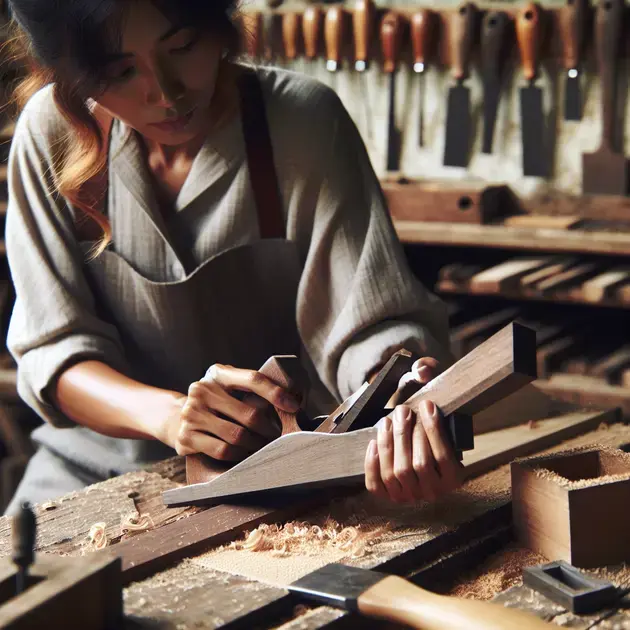Woodworking enthusiasts know the value of a reliable tool in shaping, smoothing, and finishing wood surfaces. In this essential guide to wooden hand planes, we will delve into the importance and advantages of incorporating these timeless tools into your woodworking arsenal. Wooden hand planes have been used for centuries, and their durability and versatility continue to make them a staple in any woodworker’s workshop. Whether you are a seasoned professional or a novice woodworker, understanding the various types and functions of wooden hand planes can significantly enhance the quality of your craftsmanship.

The History and Evolution of Wooden Hand Planes
Wooden hand planes have a rich history dating back to ancient times. The earliest known hand planes were found in Ancient Egypt, where they were used for shaping and smoothing wood. Over the centuries, hand planes evolved and became essential tools for woodworkers around the world. The design and materials used in hand planes changed with advancements in technology and craftsmanship.
One of the significant developments in the history of wooden hand planes was the transition from wooden bodies to metal bodies, which occurred during the Industrial Revolution. Metal hand planes offered greater durability and precision, revolutionizing woodworking practices. Despite this shift, wooden hand planes remained popular among traditional woodworkers for their craftsmanship and aesthetic appeal.
To explore more about the history and evolution of wooden hand planes, you can visit reputable woodworking websites such as FineWoodworking.com or WoodMagazine.com. These sites offer articles, videos, and forums where woodworking enthusiasts discuss the historical significance of hand planes and their role in shaping the woodworking industry.
Types of Wooden Hand Planes Every Woodworker Should Know
Woodworkers have a variety of hand planes at their disposal, each designed for specific tasks and woodworking techniques. Some of the essential types of wooden hand planes include the bench plane, block plane, smoothing plane, jack plane, and jointer plane. Each type of hand plane serves a unique purpose, from rough shaping and leveling to fine smoothing and jointing.
For beginners looking to familiarize themselves with the types of wooden hand planes, online woodworking platforms like Woodcraft.com or PopularWoodworking.com offer detailed guides and tutorials. These resources explain the differences between various hand planes, their uses, and how to choose the right one for your woodworking projects.
Exploring the types of wooden hand planes can enhance your woodworking skills and improve the quality of your craftsmanship. By understanding the unique capabilities of each hand plane, you can efficiently tackle different woodworking tasks and achieve professional results.
Tips and Techniques for Using Wooden Hand Planes
Using wooden hand planes requires skill, practice, and knowledge of proper techniques. To achieve the best results with your hand planes, it’s essential to pay attention to blade sharpening, grain direction, and hand plane maintenance. Sharpening the blade regularly ensures smooth and precise cuts, while following the wood grain direction prevents tearout and splintering.
For beginners seeking guidance on using wooden hand planes effectively, online woodworking communities like WoodNet.net or SawmillCreek.org offer forums where experienced woodworkers share tips and techniques. These platforms provide valuable insights into hand plane usage, troubleshooting common issues, and refining woodworking skills.
Experimenting with different techniques such as chamfering, edge jointing, and planing end grain can help you master the art of using wooden hand planes. By incorporating these tips into your woodworking practice, you can elevate the quality of your projects and achieve professional-level results.

Choosing the Right Wood for Hand Planes
When it comes to hand planes, choosing the right wood for the construction is crucial for the tool’s performance and durability. Different types of wood offer varying levels of stability, density, and resistance to wear and tear. One of the most popular choices for hand planes is beech wood, known for its excellent shock-absorbing properties and ability to hold its shape under pressure.
Another popular option is cherry wood, which is prized for its beautiful grain patterns and moderate density. Cherry wood is also known for its resistance to warping, making it a reliable choice for hand planes that need to maintain precision over time. Exotic woods like rosewood and ebony are also used for hand planes, offering unique aesthetics and exceptional durability.
When selecting the right wood for your hand plane, consider the type of work you will be using it for and the level of precision required. Each type of wood has its own characteristics that can enhance or detract from the performance of the tool, so choose wisely based on your specific needs and preferences.
Ultimately, the best wood for hand planes is one that strikes a balance between durability, stability, and aesthetics. Whether you prefer the classic look of beech or the exotic appeal of rosewood, selecting the right wood for your hand plane is a decision that can impact the quality of your woodworking projects for years to come.
Maintenance Tips for Wooden Hand Planes
Wooden hand planes require regular maintenance to ensure they continue to perform optimally and provide precise results. One important aspect of maintaining wooden hand planes is keeping the blade sharp. A dull blade can result in tear-out and rough surfaces, so make sure to sharpen the blade regularly using a honing guide and sharpening stones.
In addition to blade maintenance, it’s essential to keep the wooden components of the hand plane well-oiled and free from moisture. Wood is susceptible to changes in humidity, which can cause it to swell or shrink, affecting the accuracy of the hand plane. Applying a thin layer of protective oil or wax can help prevent moisture absorption and keep the wood in top condition.
Another key maintenance tip for wooden hand planes is to store them properly when not in use. Avoid leaving the hand plane exposed to direct sunlight or extreme temperatures, as this can cause the wood to warp or crack over time. Instead, store the hand plane in a cool, dry place away from moisture and fluctuations in temperature.
By following these maintenance tips and regularly inspecting your wooden hand plane for any signs of wear or damage, you can prolong its lifespan and ensure it continues to deliver exceptional performance for all your woodworking projects.
Enhancing Precision with Wooden Hand Planes
Wooden hand planes are prized for their ability to provide precise and smooth results in woodworking projects. To enhance the precision of a wooden hand plane, there are several key factors to consider. Firstly, ensure that the blade is properly adjusted and set at the correct angle for the task at hand. A sharp and properly aligned blade is essential for achieving clean and accurate cuts.
Another way to enhance precision with wooden hand planes is to pay attention to the grain direction of the wood being worked. By planing with the grain rather than against it, you can avoid tear-out and achieve smoother finishes. Take the time to analyze the wood grain and adjust your planing technique accordingly for optimal results.
Furthermore, maintaining a consistent and steady hand pressure while using a wooden hand plane is crucial for achieving precise cuts. Avoid applying excessive force or uneven pressure, as this can lead to inconsistent results and imperfections in the final piece. Practice proper hand placement and a smooth planing motion to improve the precision of your work.
By combining these techniques and paying attention to the details of blade sharpness, wood grain direction, and hand pressure, you can enhance the precision of your wooden hand plane and elevate the quality of your woodworking projects to new heights.
Conclusion
In conclusion, selecting the right wood for hand planes is a critical decision that significantly impacts the tool’s performance and longevity. Considering factors such as stability, density, and resistance to wear and tear is essential when choosing between options like beech wood, cherry wood, or exotic woods such as rosewood and ebony. Each type of wood brings its unique characteristics to the table, influencing the overall quality and precision of woodworking projects.
Furthermore, maintaining wooden hand planes is key to ensuring they deliver optimal results consistently. Regular blade sharpening, proper oiling to prevent moisture damage, and storing the hand plane correctly are essential maintenance tips to prolong its lifespan and preserve accuracy. By following these guidelines diligently, woodworkers can continue to rely on their hand planes for exceptional performance in various projects.
Lastly, enhancing precision with wooden hand planes involves attention to detail and technique. Ensuring the blade is correctly aligned, planing with the wood grain, and maintaining consistent hand pressure are vital steps to achieve clean and accurate cuts. By honing these skills and techniques, woodworkers can elevate the quality of their work, create smoother finishes, and enhance the overall precision of their woodworking projects significantly.